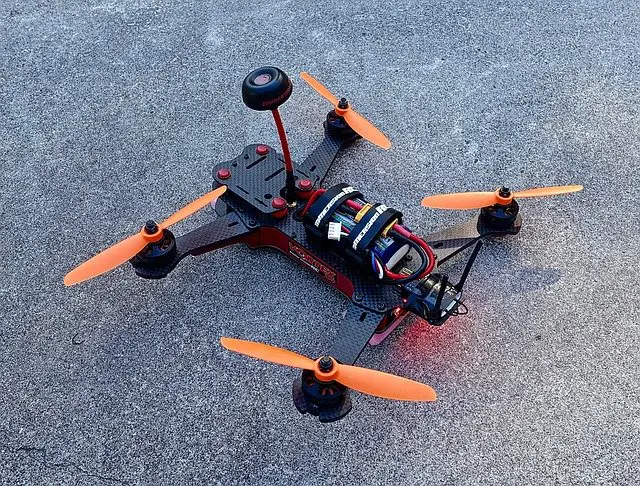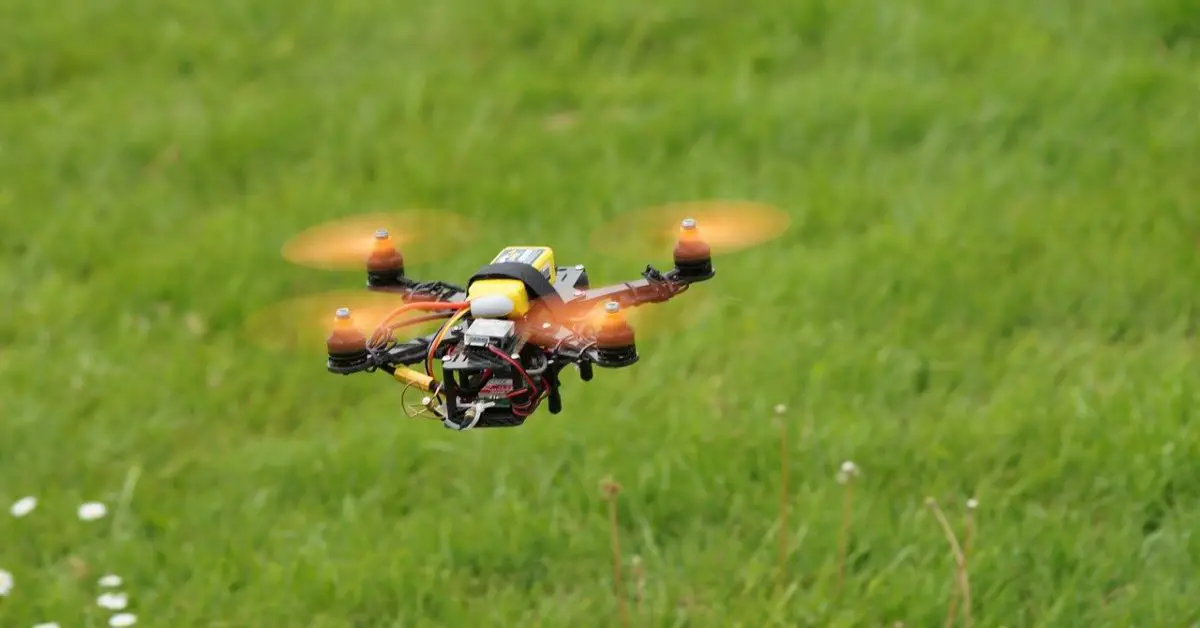Drone technology is rapidly evolving every year. One such factor that is constantly evolving is specifically the speed of a drone. This post will be focusing on the top speed a drone can fly. So, how fast can a drone fly?
The average consumer drone speed is between 40-70mph (64-113km/h). The world’s fastest racing drone has a record of 165.2mph(265.8km/h). Some military drones can reach 1,650mph(2.655km/h). Fixed-wing drones can reach speeds of 50mph(80km/h). The many physical factors that impact these speeds are what limit us to averages and not exact measurements.
The top speed of a drone will depend on many factors and no measurement will be precise. We can only make averages and estimates that we believe are closest to the truth.
How Fast Can Consumer Drones Fly?
The average drone speed of a consumer rotary-wing drone is 40-70mph (64-113km/h). There are of course some consumer drones built primarily for speed in addition to their ability to capture stunning footage in high definition.
We are not including racing, toy and fixed-wing drones as there are sections primarily focusing on them down below.
3 examples of the fastest consumer drones:
- DJI Inspire 2 [58mph (94km/h)]
- DJI Mavic Pro [40mph (65km/h)]
- DJI Phantom 4 Pro [45mph 72km/h]
How fast can toy drones fly?
The speed of a toy drone is on average 12mph (19km/h). These drones are best suited for those who do not have much experience with drones and want to start off slow.
These drones are usually small in size and very easy to use. You won’t be breaking any speed records with these but they’re still fun!
Although they don’t all go that fast, we’ve decided to provide you with 3 examples of great toy drones you could buy as a beginner drone pilot for yourself or for your kids.
3 examples of toy drones:
- Altair Falcon ($129.80)
- DJI Tello ($99)
- Hubsan X4 H107C ($39.99)
How fast can racing drones fly?
The Drone Racing League(DRL) is for professional drone racers and is operated internationally. This league satisfies a drone operator’s need for speed’.

Some of these drones are built to reach speeds of well over 130mph (209km/h). They are usually built fairly small to reduce wind resistance and increase overall speed due to better aerodynamics.
These drones are continuously increasing in speed and are sure to progress even further in the years to come.
3 examples of the fastest racing drones:
- Hobbymate Asteroid 3″ FPV [112 mph (180.2 km/h)]
- Diatone GT-R369 [125 mph (201.2 km/h)]
- Eachine Wizard TS-130 [108 mph (173.8 km/h)]
How Fast Can Fixed Wing Drones Fly?
Fixed-wing drones are drones with, well, fixed wings. These drones look similar to planes and gliders.
Their wings allow them to glide long distances and the single or multiple propellers they usually have allow them to in some cases reach high speeds.
An example of one of the fastest fixed-wing drones today is the Parrot Disco FPV drone. This fixed-wing drone is capable of reaching speeds of up to 50mph(80.4km/h)!
3 examples of the fastest fixed-wing drones available to the public (besides the Parrot Disco):
- Skywalker FPV Black X8 [53mph(85.3km/h)]
- Crazepony Sonicmodell Flywing [43mph(69.2km/h)]
- VTOL KIT 320 Fixed Wing Frame Drone [48mph(77.2km/h)]
What Impacts The Top Speed Of A Drone?
There are many factors that may affect a drone’s top speed. Most speed tests conducted on a drone will never be perfect due to the natural factors that may affect its speed which cannot always be controlled. Here are some of these factors below.
Type of drone
Different drones have different speeds. This is because they were built in a certain way with a certain intention. The three main types of drones are beginner/toy drones, trick drones and racing drones.
Beginner/toy drones
Beginner/toy drones are meant for beginners who don’t yet have much experience with drones and just want to get the feel of it. These can be used by any age group as they are easy to use.
Due to the way they’re built(shape and power of motor), they usually cannot reach very high speeds.
Trick drones
Trick drones are the more popular drones we all know about such as the DJI Mavic Pro for example. These can be used for a wide range of things such as photography, 3D mapping, surveillance or for doing tricks.
These drones are not meant for racing but the newer models are capable of reaching speeds of up to 70mph(113km/h)!
These drones are usually very stable allowing for stunning footage to be taken with no blurring.
Racing drones
Racing drones are built for speed. The frame is built in a way that best optimises the drone’s aerodynamics and its motors are specifically designed so that they can attain the maximum speed possible.
These drones are usually quite small and the materials used on them allow them to weigh very little.
A good balance must be used when creating one of these drones to avoid any unwanted results and if these factors are not properly calculated, the drone may not perform as well as expected.
What type of drone do you prefer flying?
Technology
The two main types of consumer drones are rotary-wing drones and fixed-wing drones.
The two are very different and both have benefits and drawbacks.
Rotary-wing drones
Rotary-wing drones can attain very high speeds, usually faster than fixed-wing drones. They can take off vertically due to their propellers that face upwards. Their shapes and sizes can make them very small and lightweight.
These types of drones are usually easier to control and easier to learn to use in general.
However, they require a lot of energy to stay in the air and therefore have short flight times. New technology is constantly being created to help increase flight times and speeds.
Fixed-wing drones
Fixed-wing drones have fixed wings and resemble planes or gliders. They are usually quite large in size and are capable of gliding long distances.
These types of drones are known for their long flight times and some have been created to be capable of taking off vertically as well as gliding!
These drones are usually easy to build and can be used for many purposes like 3D mapping and photography just like rotary drones.
They can utilise tailwind to further propel the drone with minimal battery and motor use. This leads to longer and faster flight times and speeds.
These drones are very fun to use but can be harder to learn.
Propellers and motors
Changing your propellers and motors can give your drone a speed boost. Having more aerodynamic propellers leads to faster speeds due to less wind resistance. Having a more powerful motor increases the power of anything that requires a motor to run.
Upgrading your propellers may give you a good boost in speed. Propellers are extremely important, and it should not be a surprise that they affect your drone’s overall speed.
Upgrading your drone’s motor is the number one way of increasing speed. A more powerful motor leads to a more powerful/faster drone!
What Is The Legal Drone Speed Limit?
Now that we’ve gone into how fast several types of drones can fly, let’s cover what’s more important but not as fun to talk about. The Federal Aviation Association (FAA) handles most things related to aviation, including drones.
One rule put in place by the FAA is the speed a drone can legally reach.
All commercial drone pilots are allowed to reach speeds of up to 100mph (161km/h) with their drones. Hobbyists however are allowed to travel at any speed with their drones.
Most commercial drones will most likely never really need to attain this incredible speed, but it still brings up the question:
Why don’t hobbyists have a drone speed limit?
What Is The Worlds Fastest Consumer Drone?
The DRL (Drone Racing League) Racer X currently holds the Guinness World Record for the fastest drone in the world. This drone managed to reach a top speed of 179mph(288.1km/h).
Here is a short video showing this drone in action:
Conclusion
Drones can come in all shapes and sizes. The numerous factors mentioned above have a direct impact on the speed of the drone. Many industry leaders and individuals are contently breaking the barriers of what’s attainable every year.
How fast do you think drones could fly in the future?
